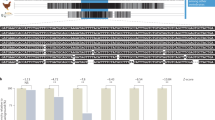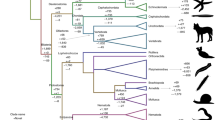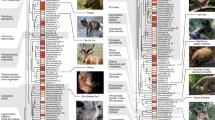Abstract
Mammalian genomes contain highly conserved sequences that are not functionally transcribed. These sequences are single copy and comprise approximately 1–2% of the human genome. Evolutionary analysis strongly supports their functional conservation, although their potentially diverse, functional attributes remain unknown. It is likely that genomic variation in conserved non-genic sequences is associated with phenotypic variability and human disorders. So how might their function and contribution to human disorders be examined?
This is a preview of subscription content, access via your institution
Access options
Subscribe to this journal
Receive 12 print issues and online access
$209.00 per year
only $17.42 per issue
Buy this article
- Purchase on SpringerLink
- Instant access to full article PDF
Prices may be subject to local taxes which are calculated during checkout



Similar content being viewed by others
References
Martinez-Cruzado, J. C., Swimmer, C., Fenerjian, M. G. & Kafatos, F. C. Evolution of the autosomal chorion locus in Drosophila. I. General organization of the locus and sequence comparisons of genes s15 and s19 in evolutionary distant species. Genetics 119, 663–677 (1988).
Culi, J. & Modolell, J. Proneural gene self-stimulation in neural precursors: an essential mechanism for sense organ development that is regulated by Notch signaling. Genes Dev. 12, 2036–2047 (1998).
Renucci, A. et al. Comparison of mouse and human HOX-4 complexes defines conserved sequences involved in the regulation of Hox-4.4. EMBO J. 11, 1459–1468 (1992).
Duret, L., Dorkeld, F. & Gautier, C. Strong conservation of non-coding sequences during vertebrates evolution: potential involvement in post-transcriptional regulation of gene expression. Nucleic Acids Res. 21, 2315–2322 (1993).
Hardison, R. C. Conserved noncoding sequences are reliable guides to regulatory elements. Trends Genet. 16, 369–372 (2000).
Hardison, R. C., Oeltjen, J. & Miller, W. Long human–mouse sequence alignments reveal novel regulatory elements: a reason to sequence the mouse genome. Genome Res. 7, 959–966 (1997).
Dermitzakis, E. T. et al. Numerous potentially functional but non-genic conserved sequences on human chromosome 21. Nature 420, 578–582 (2002).
Waterston, R. H. et al. Initial sequencing and comparative analysis of the mouse genome. Nature 420, 520–562 (2002).
Frazer, K. A. et al. Evolutionarily conserved sequences on human chromosome 21. Genome Res. 11, 1651–1659 (2001).
Mural, R. J. et al. A comparison of whole-genome shotgun-derived mouse chromosome 16 and the human genome. Science 296, 1661–1671 (2002).
DeSilva, U. et al. Generation and comparative analysis of approximately 3.3 Mb of mouse genomic sequence orthologous to the region of human chromosome 7q11.23 implicated in Williams syndrome. Genome Res. 12, 3–15 (2002).
Loots, G. G. et al. Identification of a coordinate regulator of interleukins 4, 13, and 5 by cross-species sequence comparisons. Science 288, 136–140 (2000).
Hardison, R. C. et al. Covariation in frequencies of substitution, deletion, transposition, and recombination during eutherian evolution. Genome Res. 13, 13–26 (2003).
Margulies, E. H., Blanchette, M., Haussler, D. & Green, E. D. Identification and characterization of multi-species conserved sequences. Genome Res. 13, 2507–2518 (2003).
Meisler, M. H. Evolutionarily conserved noncoding DNA in the human genome: how much and what for? Genome Res. 11, 1617–1618 (2001).
Thomas, J. W. et al. Comparative analyses of multi-species sequences from targeted genomic regions. Nature 424, 788–793 (2003).
Giardine, B. et al. GALA, a database for genomic sequence alignments and annotations. Genome Res. 13, 732–741 (2003).
Dermitzakis, E. T. et al. Comparison of human chromosome 21 conserved non-genic sequences (CNGs) with the mouse and dog genomes shows that their selective constraint is independent of their genic environment. Genome Res. 14, 852–859 (2004).
Bejerano, G. et al. Ultraconserved elements in the human genome. Science 304, 1321–1325 (2004).
Nobrega, M. A., Ovcharenko, I., Afzal, V. & Rubin, E. M. Scanning human gene deserts for long-range enhancers. Science 302, 413 (2003).
Kirkness, E. F. et al. The dog genome: survey sequencing and comparative analysis. Science 301, 1898–1903 (2003).
Dubchak, I. et al. Active conservation of noncoding sequences revealed by three-way species comparisons. Genome Res. 10, 1304–1306 (2000).
Frazer, K. A. et al. Noncoding sequences conserved in a limited number of mammals in the SIM2 interval are frequently functional. Genome Res. 14, 367–372 (2004).
Dermitzakis, E. T. et al. Evolutionary discrimination of mammalian conserved non-genic sequences (CNGs). Science 302, 1033–1035 (2003).
Keightley, P. D. & Gaffney, D. J. Functional constraints and frequency of deleterious mutations in noncoding DNA of rodents. Proc. Natl Acad. Sci. USA 100, 13402–13406 (2003).
Johnston, M. & Stormo, G. D. Evolution. Heirlooms in the attic. Science 302, 997–999 (2003).
Elnitski, L. et al. Distinguishing regulatory DNA from neutral sites. Genome Res. 13, 64–72 (2003).
Dermitzakis, E. T. & Clark, A. G. Evolution of transcription factor binding sites in mammalian gene regulatory regions: conservation and turnover. Mol. Biol. Evol. 19, 1114–1121 (2002).
Glazko, G. V., Koonin, E. V., Rogozin, I. B. & Shabalina, S. A. A significant fraction of conserved noncoding DNA in human and mouse consists of predicted matrix attachment regions. Trends Genet. 19, 119–124 (2003).
Croft, J. A. et al. Differences in the localization and morphology of chromosomes in the human nucleus. J. Cell Biol. 145, 1119–1131 (1999).
Nielsen, J. A., Hudson, L. D. & Armstrong, R. C. Nuclear organization in differentiating oligodendrocytes. J. Cell Sci. 115, 4071–4079 (2002).
Tanabe, H. et al. Evolutionary conservation of chromosome territory arrangements in cell nuclei from higher primates. Proc. Natl Acad. Sci. USA 99, 4424–4429 (2002).
Muller, H. P. & Schaffner, W. Transcriptional enhancers can act in trans. Trends Genet. 6, 300–304 (1990).
Duncan, I. W. Transvection effects in Drosophila. Annu. Rev. Genet. 36, 521–556 (2002).
Chambeyron, S. & Bickmore, W. A. Does looping and clustering in the nucleus regulate gene expression? Curr. Opin. Cell Biol. 16, 256–262 (2004).
Boffelli, D. et al. Phylogenetic shadowing of primate sequences to find functional regions of the human genome. Science 299, 1391–1394 (2003).
Nobrega, M. A., Zhu, Y., Plajzer-Frick, I., Afzal, V. & Rubin, E. M. Megabase deletions of gene deserts result in viable mice. Nature 431, 988–993 (2004).
Kioussis, D., Vanin, E., deLange, T., Flavell, R. A. & Grosveld, F. G. β-Globin gene inactivation by DNA translocation in γ-β-thalassaemia. Nature 306, 662–666 (1983).
Driscoll, M. C., Dobkin, C. S. & Alter, B. P. γ-δ-β-Thalassemia due to a de novo mutation deleting the 5′ β-globin gene activation-region hypersensitive sites. Proc. Natl Acad. Sci. USA 86, 7470–7474 (1989).
Lettice, L. A. et al. A long-range Shh enhancer regulates expression in the developing limb and fin and is associated with preaxial polydactyly. Hum. Mol. Genet. 12, 1725–1735 (2003).
Lettice, L. A. et al. Disruption of a long-range cis-acting regulator for Shh causes preaxial polydactyly. Proc. Natl Acad. Sci. USA 99, 7548–7553 (2002).
Van Laere, A. S. et al. A regulatory mutation in IGF2 causes a major QTL effect on muscle growth in the pig. Nature 425, 832–836 (2003).
Kleinjan, D. J. & van Heyningen, V. Position effect in human genetic disease. Hum. Mol. Genet. 7, 1611–1618 (1998).
Bishop, C. E. et al. A transgenic insertion upstream of sox9 is associated with dominant XX sex reversal in the mouse. Nature Genet. 26, 490–494 (2000).
Wirth, J. et al. Translocation breakpoints in three patients with campomelic dysplasia and autosomal sex reversal map more than 130 kb from SOX9. Hum. Genet. 97, 186–193 (1996).
Jamieson, R. V. et al. Domain disruption and mutation of the bZIP transcription factor, MAF, associated with cataract, ocular anterior segment dysgenesis and coloboma. Hum. Mol. Genet. 11, 33–42 (2002).
de Kok, Y. J. et al. A duplication/paracentric inversion associated with familial X-linked deafness (DFN3) suggests the presence of a regulatory element more than 400 kb upstream of the POU3F4 gene. Hum. Mol. Genet. 4, 2145–2150 (1995).
de Kok, Y. J. et al. Identification of a hot spot for microdeletions in patients with X-linked deafness type 3 (DFN3) 900 kb proximal to the DFN3 gene POU3F4. Hum. Mol. Genet. 5, 1229–1235 (1996).
Spitz, F. et al. A t(2;8) balanced translocation with breakpoints near the human HOXD complex causes mesomelic dysplasia and vertebral defects. Genomics 79, 493–498 (2002).
Flomen, R. H. et al. Construction and analysis of a sequence-ready map in 4q25: Rieger syndrome can be caused by haploinsufficiency of RIEG, but also by chromosome breaks approximately 90 kb upstream of this gene. Genomics 47, 409–413 (1998).
Rose, C. S., Patel, P., Reardon, W., Malcolm, S. & Winter, R. M. The TWIST gene, although not disrupted in Saethre–Chotzen patients with apparently balanced translocations of 7p21, is mutated in familial and sporadic cases. Hum. Mol. Genet. 6, 1369–1373 (1997).
Spitz, F., Gonzalez, F. & Duboule, D. A global control region defines a chromosomal regulatory landscape containing the HoxD cluster. Cell 113, 405–417 (2003).
McArthur, M., Gerum, S. & Stamatoyannopoulos, G. Quantification of DNaseI-sensitivity by real-time PCR: quantitative analysis of DNaseI-hypersensitivity of the mouse β-globin LCR. J. Mol. Biol. 313, 27–34 (2001).
Cawley, S. et al. Unbiased mapping of transcription factor binding sites along human chromosomes 21 and 22 points to widespread regulation of noncoding RNAs. Cell 116, 499–509 (2004).
Morley, M. et al. Genetic analysis of genome-wide variation in human gene expression. Nature 430, 743–747 (2004).
Acknowledgements
We thank H. Attar for helping us with the analysis and collection of data. The authors are supported by grants from the Swiss National Science Foundation, the National Center of Competence in Research 'Frontiers in Genetics', the US National Institutes of Health, the European Union, the 'ChildCare' Foundation, the Jerome Lejeune Foundation and the Wellcome Trust.
Author information
Authors and Affiliations
Corresponding authors
Ethics declarations
Competing interests
The authors declare no competing financial interests.
Related links
Glossary
- HISTONE CODE
-
Post-translational modifications of histone tails that involve characteristic clusters of modifications, including acetylation, phosphorylation, ubiquitylation, methylation and ADP-ribosylation, which combine to create an epigenetic mechanism for the regulation of gene expression.
- IN VIVO FOOTPRINTING
-
An assay that detects the presence of protein binding onto DNA in an in vivo system.
- PREAXIAL POLYDACTYLY
-
Addition of fingers or toes on the thumb side of the hand or the big toe side of the foot.
- SOUTHWESTERN ANALYSIS
-
An assay, in which one runs proteins on a PAGE gel, blots the gel and then hybridizes the membrane with labelled DNA. The goal is to identify protein–DNA interactions.
- TRANSVECTION
-
A phenomenon whereby homologous chromosomes are synapsed in somatic cells, as a result of which some enhancers and/or silencers can function in trans.
- YEAST 1-HYBRID
-
An assay that uses transcriptional activation in yeast as a model to detect protein–DNA interactions.
- ZONE OF POLARIZING ACTIVITY
-
A small region in the developing limb bud that is responsible for correct patterning of the anterior–posterior axis of the limb.
Rights and permissions
About this article
Cite this article
Dermitzakis, E., Reymond, A. & Antonarakis, S. Conserved non-genic sequences — an unexpected feature of mammalian genomes. Nat Rev Genet 6, 151–157 (2005). https://doi.org/10.1038/nrg1527
Issue Date:
DOI: https://doi.org/10.1038/nrg1527



